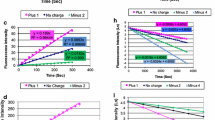Abstract
Gap junction (GJ) research has entered a new stage focusing the concerted dynamic behavior of multiple isoforms of connexin (Cx) in the cell membrane, cytosolic vesicles, and space between them. To proceed with this research, imaging technologies are important. Here we describe two novel protocols for this purpose. At first, the adoption of a small motif of Cys-Cys-X-X-Cys-Cys as a visualization tag is described. An As complex, FlAsH, can bind to this tetra-Cys (TC) tag to form a fluorescent conjugate. Its introduction into the C-terminal of Cx43 is demonstrated. Next, a novel triangle chip for the accurate x-y registration is described. Target single cells of HeLa marked with a fluorescent dye can be easily recognized by electron microscopy based on this chip.
Access this chapter
Tax calculation will be finalised at checkout
Purchases are for personal use only
Similar content being viewed by others
References
Oyamada M, Takebe K, Endo A, Hara S, Oyamada Y (2013) Connexin expression and gap-junctional intercellular communication in ES cells and iPS cells. Front Pharmcol 4:Article 85. https://doi.org/10.3389/fphar.2013.00085
Aasen T (2015) Connexins: junctional and non-junctional modulators of proliferation. Cell Tissue Res 360:685–699. https://doi.org/10.1007/s00441-014-2078-3
Söhl G, Willecke K (2003) An update on connexin genes and their nomenclature in mouse and man. Cell Commun Adhes 10:173–180
Axelsen LN, Calloe K, Holstein-Rathlou N-H, Nielsen MN (2013) Managing the complexity of communication: regulation of gap junctions by post-translational modification. Front Pharmacol 4:Article 130
Stout RF Jr, Snapp EL, Spray DC (2015) Connexin type and fluorescent protein-fusion tag determine structural stability of gap junction plaques. J Biol Chem 290:23497–23515
Thévenin AF, Kowal TJ, Fong JT, Kells RM, Fisher CG, Falk MM (2013) Proteins and mechanisms regulating gap-junction assembly, internalization, and degradation. Physiology 28:93–116. https://doi.org/10.1152/physiol.00038.2012
Aasen T, Leithe E, Graham SV, Kameritsch P, Mayán MD, Mesnil M et al (2019) Connexins in cancer: bridging the gap to the clinic. Oncogene 38:4429–4451. https://doi.org/10.1038/s41388-019-0741-6
Sirnes S, Bruun J, Kolberg M, Kjenseth A, Lind GE, Svindland A et al (2012) Connexin43 acts as a colorectal cancer tumor suppressor and predicts disease outcome. Int J Cancer 131:570–581
Wang ZS, Wu LQ, Yi X, Geng C, Li YJ, Yao RY (2013) Connexin-43 can delay early recurrence and metastasis in patients with hepatitis B-related hepatocellular carcinoma and low serum alpha-fetoprotein after radical hepatectomy. BMC Cancer 13:306. https://doi.org/10.1186/1471-2407-13-306
Brockmeyer P, Jung K, Perske C, Schliephake H, Hemmerlein B (2014) Membrane connexin 43 acts as an independent prognostic marker in oral squamous cell carcinoma. Int J Oncol 45:273–281
Poyet C, Buser L, Roudnicky F, Detmar M, Hermanns T, Mannhard D et al (2015) Connexin 43 expression predicts poor progression-free survival in patients with non-muscle invasive urothelial bladder cancer. J Clin Pathol 68:819–824
Saito M, Asai Y, Imai K, Hiratoko S, Tanaka K (2017) Connexin30.3 is expressed in mouse embryonic stem cells and is responsive to leukemia inhibitory factor. Sci Rep 7:42403. https://doi.org/10.1038/srep42403
Hoffmann C, Gaietta G, Zurn A, Adams SR, Terrillon S, Ellisman MH et al (2010) Fluorescent labeling of tetracysteine-tagged proteins in intact cells. Nat Prot 5:1666–1677
Saito M, Imai K, Koyama M (2016) A tetracysteine-tag and HeLa cell system for the dynamic analysis of the localization and gating properties of a specific connexin isoform. Electrochemistry 84(5):299–301. https://doi.org/10.5796/electrochemistry.84.299
Haraguchi T, Osakada H, Koujin T (2015) Live CLEM imaging to analyze nuclear structures at high resolution. In: Nakagawa S, Hirose T (eds) Nuclear bodies and noncoding RNAs—methods and protocols, methods in molecular biology 1262, Springer Protocols. Humana Press, Totowa, pp 89–103
Peddie CJ, Domart MC, Snetkov X, O'Toole P, Larijani B, Way M et al (2017) Correlative super-resolution fluorescence and electron microscopy using conventional fluorescent proteins in vacuo. J Struct Biol. pii: S1047-8477(17)30093-X. https://doi.org/10.1016/j.jsb.2017.05.013
Ariotti N, Hall TE, Parton RG (2017) Correlative light and electron microscopic detection of GFP-labeled proteins using modular APEX. Methods Cell Biol 140:105–121. https://doi.org/10.1016/bs.mcb.2017.03.002
Saito M, Hiratoko S, Fukuba I, Tate S, Matsuoka H (2018) Use of a right triangle chip and its engraved shape as a transferrable x-y coordinate system from light microscopy to electron microscopy. Electrochemistry 86(1):6–9
Yamada Y, Yamaguchi N, Ozaki M, Shinozaki Y, Saito M, Matsuoka H (2008) Instant cell recognition system using microfabricated coordinate standard chip useful for combinable cell observation with multiple microscopic apparatus. Microsc Microanal 14:236–242. https://doi.org/10.1017/S1431927608080252
Saito M, Matsuoka H (2010) Semi-quantitative analysis of transient single-cell gene expression in embryonic stem cells by femtoinjection. In: Zhang B (ed) RNAi and microRNA-mediated gene regulation in stem cells, Methods in molecular biology 650. Humana Press, Totowa, pp 155–170. https://doi.org/10.1007/978-1-60761-769-3_13
Acknowledgments
We thank Prof. Emer. Hideaki Matsuoka of Tokyo University of Agriculture and Technology for his valuable advice on cell analysis.
Author information
Authors and Affiliations
Corresponding author
Editor information
Editors and Affiliations
Rights and permissions
Copyright information
© 2020 Springer Science+Business Media New York
About this protocol
Cite this protocol
Saito, M. (2020). Fluorescent Labeling of Connexin with As Complex and X-Y Coordinate Registration of Target Single Cells Based on a Triangle Standard Chip for the Image Analysis of Gap Junctional Communication. In: Turksen, K. (eds) Stem Cell Renewal and Cell-Cell Communication. Methods in Molecular Biology, vol 2346. Humana, New York, NY. https://doi.org/10.1007/7651_2020_330
Download citation
DOI: https://doi.org/10.1007/7651_2020_330
Published:
Publisher Name: Humana, New York, NY
Print ISBN: 978-1-0716-1569-0
Online ISBN: 978-1-0716-1570-6
eBook Packages: Springer Protocols



